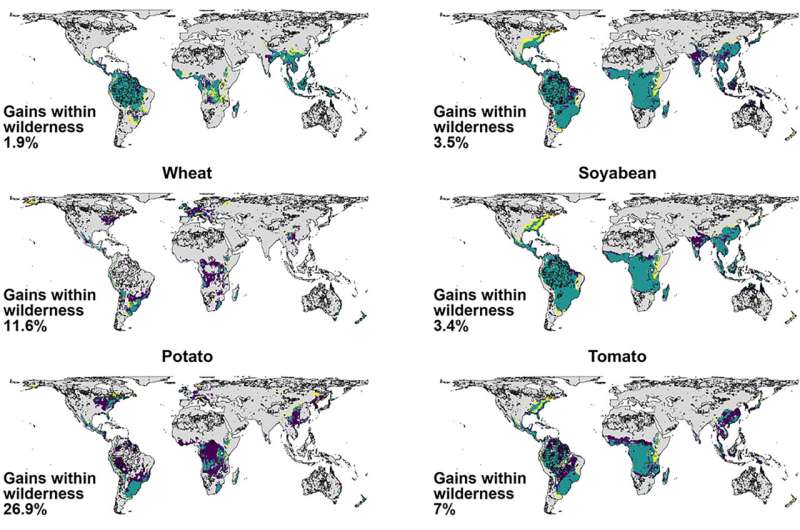This article has been reviewed according to Science X's editorial process and policies. Editors have highlighted the following attributes while ensuring the content's credibility:
fact-checked
peer-reviewed publication
trusted source
proofread
High-latitude wilderness may be threatened by agriculture as the climate warms

Humanity must cut carbon emissions and use farmland more efficiently to protect our planet's remaining wilderness, new research shows.
Climate change is making some wilderness areas more suitable for crop growing, heightening the risk of agricultural expansion, especially in northern areas including Canada, Scandinavia and Russia.
By assessing "future climate suitability" for more than 1,700 crop varieties, the study projects 2.7 million square kilometers of wilderness will become newly suitable for agriculture over the next 40 years.
This is 7% of the world's total remaining wilderness outside Antarctica.
The study, by the University of Exeter, also projects that the variety of crops that can be grown will decrease on 72% of currently cultivable land worldwide—further driving pressure to expand farming into wilderness. The paper, published in the journal Current Biology, is titled, "Wilderness areas under threat from global redistribution of agriculture."
"Only a few areas of our planet remain relatively untouched by human influence," said Professor Ilya Maclean, of the Environment and Sustainability Institute at Exeter's Penryn Campus in Cornwall.
"By warming our planet, we are simultaneously making existing farmland less productive and opening possible new areas for farming, especially in the far north.
"Without protection, these precious areas of wilderness—with their great biodiversity and cultural value—could be irreversibly lost."
Agriculture expansion is already the main cause of biodiversity loss on land globally, and food production may have to double by 2050 to meet the demands of growing human populations.
"To protect our planet's remaining wilderness, we must urgently cut emissions of greenhouse gases," said Dr. Alexandra Gardner, also from the Environment and Sustainability Institute.
"We must also use our farmland more efficiently.
"We can feed a larger population on the farmland we already have, but we need to increase cropping efficiency, grow the right crops for the conditions, reduce meat consumption (which is inefficient and produces high emissions) and cut food waste."
The projection of 2.7 million square kilometers of wilderness becoming newly suitable for agriculture in 40 years is based on a high-emissions future (the RCP8.5 climate scenario). Under a medium scenario (RCP4.5), the area is 1.85 million km2.
More information: Wilderness areas under threat from global redistribution of agriculture, Current Biology (2023). DOI: 10.1016/j.cub.2023.09.013. www.cell.com/current-biology/f … 0960-9822(23)01229-0
Journal information: Current Biology
Provided by University of Exeter




















